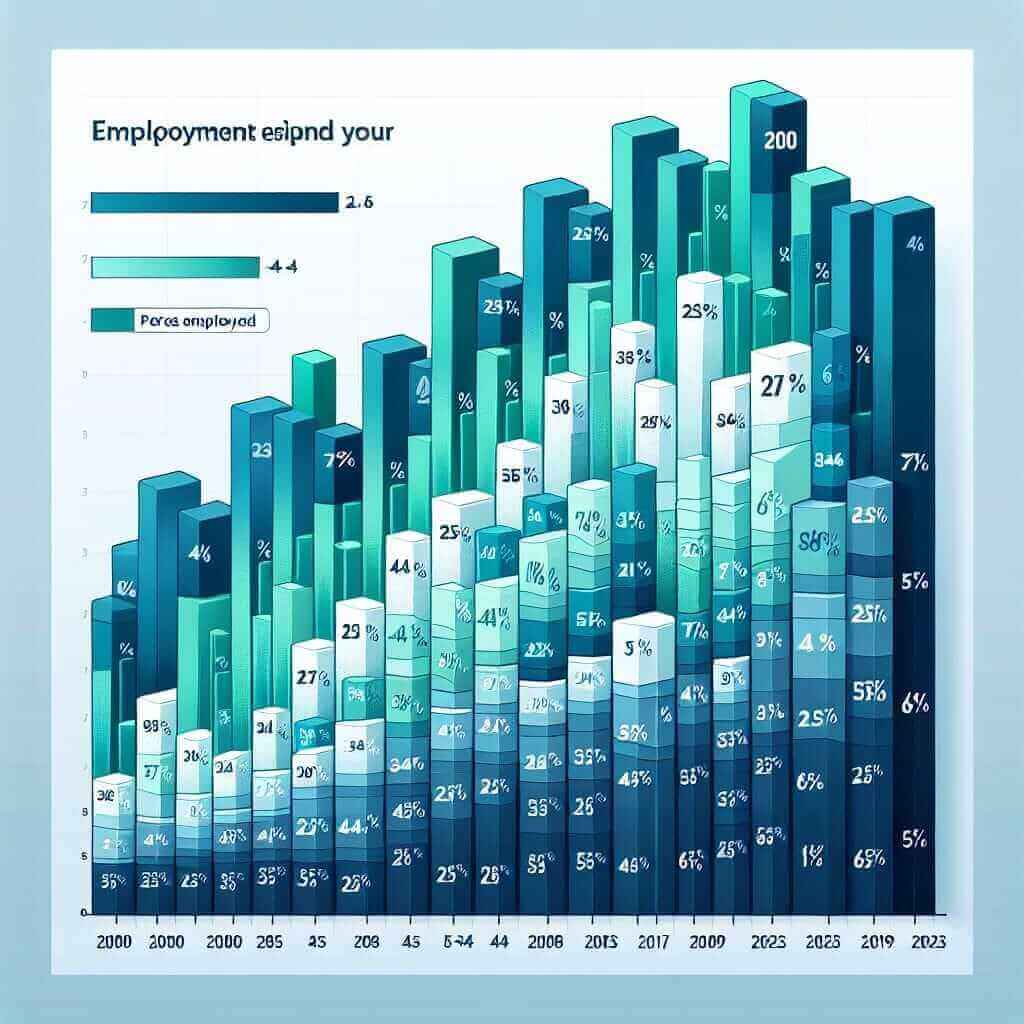In the IELTS Writing Task 1, learners often encounter questions that require them to compare data across different categories. One common topic is comparing levels of employment in different age groups over a period. This topic not only assesses your ability to interpret data but also your skill in articulating trends and comparisons concisely and accurately.
Let’s delve deeper into this topic by analyzing employment data trends for various age groups from 2000 to 2023. We’ll create mock exam questions, analyze a sample question, provide model answers, and outline key grammatical and lexical resources needed for a high-scoring essay.
Sample Exam Questions
Here are three mock exam questions related to the theme of employment levels across age groups:
-
Mock Question 1:
The bar chart below shows the employment rates among different age groups (18-24, 25-34, 35-44, 45-54, 55-64, 65+) in 2000 and 2023. Summarize the information by selecting and reporting the main features, and make comparisons where relevant. -
Mock Question 2:
The line graph below illustrates the trend in employment rates for three age groups (18-24, 25-34, 35-44) from 2000 to 2023 in a particular country. Summarize the information by selecting and reporting the main features, and make comparisons where relevant. -
Mock Question 3:
The table below provides data on the employment rates of the 18-24, 25-34, and 35-44 age groups in 2000, 2013, and 2023. Summarize the information by selecting and reporting the main features, and make comparisons where relevant.
Choosing a Sample Question
For this exercise, we’ll focus on Mock Question 1:
The bar chart below shows the employment rates among different age groups (18-24, 25-34, 35-44, 45-54, 55-64, 65+) in 2000 and 2023. Summarize the information by selecting and reporting the main features, and make comparisons where relevant.
Data Analysis and Visualization
To proceed, we must imagine or gather real data that might look like this (assuming fictional data for illustrative purposes):
| Age Group | Employment Rate (2000) | Employment Rate (2023) |
|---|---|---|
| 18-24 | 55% | 60% |
| 25-34 | 75% | 80% |
| 35-44 | 85% | 88% |
| 45-54 | 80% | 78% |
| 55-64 | 60% | 65% |
| 65+ | 20% | 25% |

Sample Answer Analysis
Analyzing the Task
- Overview: Identify the overall trend and significant changes.
- Details: Provide specific details, and make comparisons between the age groups and the years.
Sample Answer
Examining the bar chart reveals notable trends in employment rates among six different age groups in the years 2000 and 2023. Overall, employment rates have generally increased across most age groups, although some groups have experienced slight decreases.
In 2000, the employment rate for those aged 18-24 was 55%. By 2023, this figure had risen moderately to 60%. A similar upward trend is observed in the 25-34 age group, with an increase from 75% in 2000 to 80% in 2023. The 35-44 age group had the highest employment rates in both years, starting at 85% in 2000 and reaching 88% in 2023.
Contrastingly, the 45-54 age group saw a marginal decline from 80% in 2000 to 78% in 2023. For individuals aged 55-64, there was a noteworthy rise from 60% to 65% over the 23-year period. Lastly, the elderly group of 65+ saw a modest increase from a 20% employment rate in 2000 to 25% in 2023.
In summary, while most age groups experienced increased employment rates between 2000 and 2023, the 45-54 age group was the exception, showing a minor decline.
Word Count: 203
Writing Tips
-
Grammar and Structure:
- Use comparative and superlative forms to show differences (e.g., “higher,” “the highest,” “slight increase”).
- Employ the past simple tense to describe changes over time (e.g., “rose,” “declined”).
-
Vocabulary:
- Increase/decrease phrases: “rose from x% to y%,” “declined by x%.”
- Adjectives and adverbs: “moderately,” “noteworthy,” “modest.”
-
Examples of Sentence Structures:
- “The employment rate for the 18-24 age group increased moderately from 55% to 60% over the period.”
- “In contrast, the 45-54 age group experienced a slight decrease in employment, from 80% to 78%.”
Difficult Vocabulary
- Marginal (adj.) /ˈmɑːdʒɪnəl/: Pertaining to a minimal amount.
- Upward trend (n.) /ˈʌpwərd trɛnd/: A general increase over time.
- Contrastingly (adv.) /kənˈtræstɪŋli/: In contrast; showing a difference.
- Modest (adj.) /ˈmɒdɪst/: Limited in size/amount.
- Noteworthy (adj.) /ˈnoʊtˌwɜːrði/: Worth paying attention to.
Conclusion
For the IELTS Writing Task 1, mastering the skill of comparing data is crucial. By focusing on accurate data interpretation, employing appropriate grammar and vocabulary, and practicing regularly, candidates can achieve a high band score. Make sure to organize your answer clearly, provide specific details, and draw insightful comparisons to meet the standards of a Band 7+ essay.